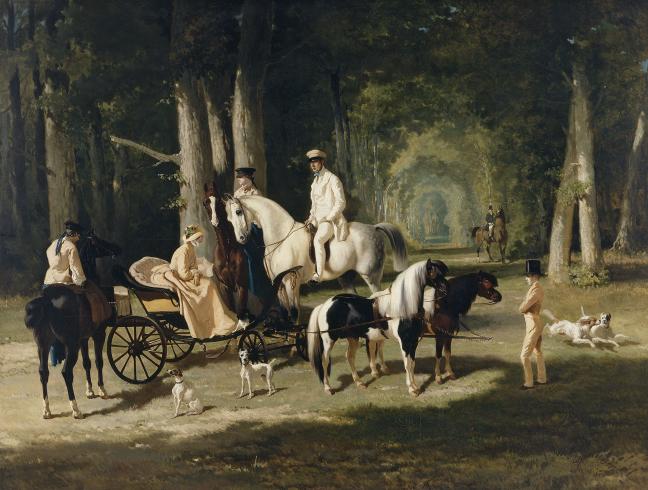This large family portrait, painted by de Dreux for the Salon of 1848, celebrates a way of life and social success. This work in monumental format has all the aspects of a formal portrait while at the same time turning the composition into a genre scene: a walk in the woods in the shade of the large trees of a bridle path.
The work refers to the custom during the July Monarchy of riding on horseback or in a carriage along the Champs-Elysées. The members of the Mosselman family form a circle around Eugènie Gazzani, sitting in a petit-duc carriage pulled by Shetland ponies. Her husband is on horseback alongside their older daughter, Charlotte, while Pauline, the younger daughter, is facing them on the other side of the carriage. The Mosselmans’ elegant but unfussy outfits are composed of a rich range of pinks and whites which play with the contrasting light in the clearing.
In this successful work, de Dreux demonstrates that he is an experienced portrait painter but above all an animal painter, whose horses seem to take an active part in the scene. The racing whippets, hunting and riding companions, add a very British touch to the riders’ pose. The landscape, which reveals nothing about the exact location, uses a theme dear to painters of the Barbizon school and English landscape artists, with its long wooded perspective and flourishing plant life.
From his early days at the Salon of 1831, until his last participation in 1859, de Dreux enjoyed success as painter to the court of Orleans and a specialist in equestrian subjects, which was very popular with high society. The English fashion which was then influencing Parisian society and which followed a new artistic sensibility, developed a fondness for nature, of which landscape art and equestrian pastimes were amongst the most popular expressions.
By contacting de Dreux to paint their family portrait, the Mosselmans were acting in keeping with this remarkable July Monarchy society which was open to new fashions. This type of society was later eclipsed by the Revolution of 1848 and the exile of the Orleans family to England, but regained its influence during the French Second Empire. The Mosselman family owed their fortune to the zinc mines and foundries which they owned in Belgium. Alfred Mosselman was also known throughout literary and high society Paris for his long liaison with Madame Sabatier, the muse of Clésinger and Baudelaire, whose salon was famous.
I. C.

City of Paris municipal collection's website
The collections portal can be used to search the collections of Paris’s 14 municipal museums (approximately 336,000 works, including 43,000 belonging to the Petit Palais).
It is also possible to download around 12,000 images of the museum’s works free of charge.
Access the Museums of the City of Paris collections portal
Extern databases
Discover a selection of databases online presenting works from the Petit Palais or documents concerning the history of the museum.

